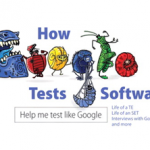Introduction
Keyword-driven methodologies like Action Based Testing (ABT) are usually considered to be an Automation technique. They are commonly positioned as an advanced and practical alternative to other techniques like to “record & playback” or “scripting”.
To see ABT as an Automation technique is not incorrect. We do it ourselves at LogiGear in marketing. Some parts of ABT, and the supporting toolset TestArchitect, are very technical and would not fit in a manual process. However, in this article I want to show that the core ideas of ABT are not specifically about automation at all, they are merely a style of test design.
ABT as a Style for Writing a Test
Consider, for example, this small manual test instruction regarding a registration dialog (see Example 1). I found this instruction in one of our earlier projects:
| Enter a user id that is greater than 10 characters in the user id field. Then enter proper information for all the other fields on the screen and click the ‘Continue’ button.
The following error message should be displayed below the screen: ‘A User Id must be less than 10 characters’. |
Example 1 – Manual Test Instruction
At first glance, there does not appear to be a lot wrong with this instruction. It is a proper and very common instruction in a manual test suite. However, when examined more closely a few things can be noted:
- First, the input values mentioned in the instruction are “implicit”; they are circumscribed rather than explicitly specified. The text calls for “a user id that is greater than 10 characters” and “proper information”. This is not a big deal in most cases, but it is not always efficient. It calls for the tester to supply the actual values when the test case is executed, meaning:
- The tester has to spend time and effort every time the test case is executed, while if the values had been specified as part of the test design this would have happened only once.
- This test case execution effort happens typically near the end of a project, when not much time is left for the tester to be expending “extra” effort.
- Furthermore, an instruction like “click the ‘Continue’ button” is likely to be repeated for every test case related to this dialog. In this example that is not much of a problem, but in many test case descriptions I have seen instructions can be very detailed and extensive, and are repeated over and over again in each test case. This means:
- A lot of work for the test designer to create these instructions and make sure they are correct.
- The instructions are quickly rendered outdated if anything changes in the system under test. This means that the instructions either have to be modified, or, in many cases, they are simply left alone, being incorrect. After a number of maintenance cycles the test cases become obsolete, thus losing a valuable investment.
In general manual instructions tend to be verbose, voluminous, and hard to create and maintain. Executing manual instruction costs a lot of time and labor, often when a project is already under time pressure.
Using ABT the same test would be written in a spreadsheet, and typically look like this:
|
Example 2 – ABT Test Instruction
Compared to the earlier version (Example 1) a number of differences can be seen:
- The format of the instruction is much shorter, taking less time for the test designer to create.
- The input value for user id is now specified explicitly. The tester no longer needs to come up with one.
- Input values not relevant to the test (the “other fields”) are left to the action to use default values. This focuses on what matters for the test which increases readability and improves maintainability.
- Other details, like the need to click on the “continue” button or where to find the error message, are also hidden in the action and equally guarded against changes in the system under test.
Notice that the action-based format used here does not assume Automation at all. It is just another way of writing a test. The test case can be executed equally well manually as it can be with Automation. An experienced tester, who is familiar with operating the system under test, can follow this instruction and execute the test case manually.
However, two considerations remain for use of the short action-based format for manual tests:
- The executing manual tester must be experienced, and experienced with the system under test. This is not always a valid assumption.
- Since they are not specified, the manual tester will still have to supply values for the other fields in the dialog during test execution.
The way around these limitations is to let the test designer spend time to define the “check registration” action in more detail, just like would be done when automating this test. And just like with Automation, this specification, which we call “action definition”, will only have to be done once, thus also improving maintainability. For a manual test this definition will be specified as template text, with place holders for the arguments for which the manual tester will need to supply the actual values. In TestArchitect we even have added a function that will do this automatically – it will generate a document in which all actions are re-placed with the template texts specified in their definitions, and the place holders replaced by the actual argument values.
Conclusion
What I hope I have illustrated in this article is that Action Based Testing, and keyword based methods in general, are not necessarily Automation techniques. They are most of all an economic way of describing tests. They are a style or a format for writing a test instruction.



















